
Quarks' Spins Dictate Their Location in the Proton |
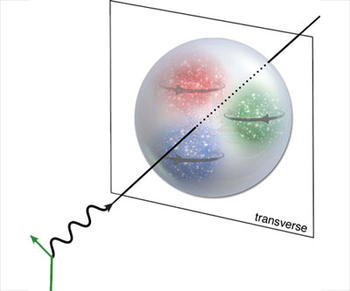
In a proton, quarks with spin pointed in the up direction (red and blue) tend to gather in the left half of the proton as seen by the incoming electron, whereas down-spinning quarks (green) tended to gather in the right half of the proton.
A successful measurement of the distribution of quarks that make up protons has found that a quark's spin can predict its general location inside the proton. Quarks with spin pointed up will congregate in the left half of the proton, while down-spinning quarks hang out on the right. The research also confirms that scientists are on track to the first-ever three-dimensional inside view of the proton. The proton lies at the heart of every atom that builds our visible universe, yet scientists are still struggling to obtain a detailed picture of how it is composed of its primary building blocks: quarks and gluons. Too small to see with ordinary microscopes, protons and their quarks and gluons are instead illuminated by particle accelerators. At Jefferson Lab, the CEBAF accelerator directs a stream of electrons into protons, and huge detectors then collect information about how the particles interact. According to Harut Avakian, a Jefferson Lab staff scientist, these observations have revealed important basic information on the proton's structure, such as the number of quarks and their momentum distribution. This information comes from scattering experiments that detect only whether a quark was hit, but do not measure the particles produced from interacting quarks. "If you sum the momenta of those quarks, it can be compared to the momentum of the proton. What scientists were doing these last 40 years, they were investigating the momentum distribution of quarks along the direction in which the electron looks at it – a one-dimensional picture of the proton," he explains.... more |
|
|
Lab Participates in Statewide Tornado Drill
|
Lab Hosts Talk by Physicist Who Helped Discover the Higgs Boson
|
Student Reflects on Benefits, Opportunities Afforded by JSA Assistantship
|
||
|
|
||||
Below the Fold:
|
||||
|
|
||||
Quarks' Spins Dictate Their Location in the Proton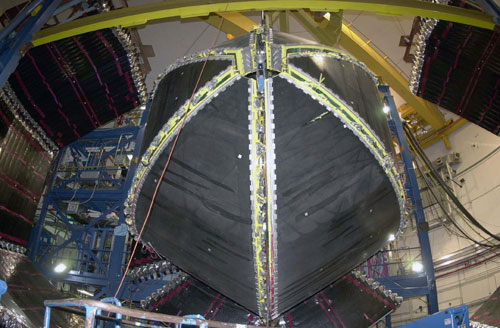
The CLAS collaboration conducted the experiment in Jefferson Lab's Experimental Hall B in the spring of 2005. The first result was published in September 2012 in the journal Physical Review Letters. Pictured is a portion of the CEBAF Large Acceptance Spectrometer.
A successful measurement of the distribution of quarks that make up protons has found that a quark's spin can predict its general location inside the proton. Quarks with spin pointed up will congregate in the left half of the proton, while down-spinning quarks hang out on the right. The research also confirms that scientists are on track to the first-ever three-dimensional inside view of the proton. The proton lies at the heart of every atom that builds our visible universe, yet scientists are still struggling to obtain a detailed picture of how it is composed of its primary building blocks: quarks and gluons. Too small to see with ordinary microscopes, protons and their quarks and gluons are instead illuminated by particle accelerators. At Jefferson Lab, the CEBAF accelerator directs a stream of electrons into protons, and huge detectors then collect information about how the particles interact. According to Harut Avakian, a Jefferson Lab staff scientist, these observations have revealed important basic information on the proton's structure, such as the number of quarks and their momentum distribution. This information comes from scattering experiments that detect only whether a quark was hit, but do not measure the particles produced from interacting quarks. "If you sum the momenta of those quarks, it can be compared to the momentum of the proton. What scientists were doing these last 40 years, they were investigating the momentum distribution of quarks along the direction in which the electron looks at it – a one-dimensional picture of the proton," he explains. Now, he and his colleagues have used a new experimental method that can potentially produce a full three-dimensional view of the proton. The method measures neutral pions, made of one quark and one antiquark, as they are produced in collisions of fast-moving electrons with protons. In addition to the momentum distribution, this method allows one to infer the spatial position of the quark as it was hit – how far the quarks are away from the proton's center and if their spins are pointing in the up or down direction. It projects a spatial image of the proton's quark content in the plane transverse to the electron beam. "It is the transverse space distribution. And so the one-dimensional picture is extended to a three-dimensional image that allows us to understand how those little quarks are distributed in the space. That is, we learn at the same time how far they are from the center and what are their momenta," Avakian says. To make the measurement, the researchers needed to thwack a number of quarks with electrons just hard enough for the quarks to absorb energy from the electrons and then give it away again, without ever breaking up the protons. "This is the method of exclusive electron scattering, where you don't destroy the proton, you just touch a single quark," explains JLab Theorist Christian Weiss. "The electron hits the quark, and this quark shakes off a pion. The quark returns to the proton, and the proton remains intact and recoils. You measure the pion and the recoiling proton in addition to the scattered electron. This method gives you much more control than traditional inclusive scattering, where you do not detect the produced particles." However, the experimental data alone isn't enough. To extract detailed information, the experimenters must plug their data into a complicated theory expressed as a set of mathematical expressions, called generalized parton distributions. The expressions combine to provide detailed information on how both the quarks and gluons, together called partons, behave inside the proton. It's thought that these generalized parton distributions, along with other information, will provide the first-ever three-dimensional view of the proton's structure. "It's like you have some mosaic. These are parts of your mosaic. To get the picture, you need all these pieces to put together," Avakian says. The CLAS collaboration conducted the experiment in Jefferson Lab's Experimental Hall B in the spring of 2005. The first result was published last fall in the journal Physical Review Letters. They found that it was possible to successfully carry out an experiment using this tricky method of probing the proton without destroying it to get the data they need for the generalized parton distributions. They plugged the data into two theoretical models of generalized parton distributions that simulate the spin and location of the quarks and allow one to recover a genuine three-dimensional image of the proton. "The position of the quark depends on how its spin is pointing or on its momentum. The spin of the quark affects the probability to find the quark in a certain point in space," Avakian explains. In particular, they found evidence that transversely spinning quarks with their spin pointed in the up direction tended to gather in the left half of the proton as seen by the incoming electron, whereas transversely spinning quarks with their spin pointed in the down direction tended to gather in the right half of the proton. He says the result confirms that protons are complex systems, with a rich internal structure and sophisticated dynamics, referred to as Quantum Chromodynamics. "The quarks are not just distributed in momentum in one direction. They have momenta, positions, and everything is moving around. As of now, we don't understand very well the dynamics, such as how this spin is correlated with the position and the momentum. That's what we are trying to study – the interplay of the quark's internal motion and their spin with their spatial position in the system," Avakian says. In the meantime, Avakian and Weiss both agree that this successful experiment has broader implications. It has proven that the exclusive electron scattering method can be used to begin filling in the information needed for generalized parton distributions toward obtaining that three-dimensional view of the proton. Physicists worldwide are working toward that common goal, and the technique pioneered here can also be applied at much higher energies, beginning with Jefferson Lab's CEBAF accelerator at 12 GeV and later with a future Electron-Ion Collider. Similar measurements can also be performed in scattering experiments with proton beams at facilities such as GSI in Germany and at Japan's High Energy Accelerator Research Organization, known as KEK. "The physics community consider this as a first-priority task: To understand the 3D structure of the nucleon," Avakian says. By Kandice Carter |
||||
|
|
||||
Lab Participates in Statewide Tornado Drill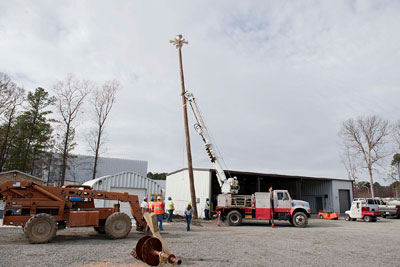
To notify individuals working outdoors at Jefferson Lab of Tornado Warnings and tornado activity near to the lab, management and ES&H staff had a tornado siren installed in December 2011. The siren is tested on the first work Friday of every month. More about the lab's response procedures is available on the Emergency Management webpage.
During the past two years, 62 tornadoes struck Virginia, killing 10 people and injuring more than 100. To encourage tornado awareness and safety, Gov. Bob McDonnell proclaimed March 12 as Tornado Preparedness Day. "Tragically, many Virginia families and communities have been affected by deadly tornadoes in recent years, and recovery continues in many places," said Michael Cline, state coordinator for the Virginia Department of Emergency Management. "Knowing what to do when a tornado warning is issued can save your life." And with this goal in mind, VDEM staff encourages everyone to participate in tornado drills. At 9:45 a.m. on March 12, businesses and organizations, schools and colleges, and families and individuals participated in the Statewide Tornado Drill. Jefferson Lab was among the many participants. At that time, the National Weather Service sent a test tornado warning that triggered a tone alert and broadcast message. The message was picked up by many TV and radio broadcasters, simulating what listeners hear during an actual tornado warning. Jefferson Lab sent out email and page messages over its sitewide alert system, and sounded its tornado siren to notify workers who were outdoors. The procedure for responding to tornado warnings and tornado sightings at or near the lab is to seek shelter immediately in a Severe Wind Take Cover area, according to JLab Emergency Manager Tina Menefee. She urges everyone to review the Emergency Plan placards posted in hallways or on the walls or safety bulletin board of lab buildings and work areas. "Know in advance where you need to go to take shelter," she says. In the event of a tornado warning or a tornado, people should move as quickly as possible:
"The best and fastest way for anyone to get a tornado warning is by NOAA Weather Radio," said Bill Sammler, NWS warning coordination meteorologist. "With a weather radio, you get weather data directly from the nearest National Weather Service office (Wakefield, Va., for much of Eastern Virginia, including Jefferson Lab). When we issue a tornado warning, the weather radio sounds an alarm or flashes lights and then gives information on where the storm is, which way it's moving, and telling people in its path to take cover." NOAA Weather Radios with SAME alerts are available at electronics and sporting goods stores, discount and department stores, and online. They come in battery-powered models, and many also have AM/FM bands. A special needs NOAA Weather Radio is available as well. The special-needs NOAA Weather Radio can warn deaf and hard-of-hearing persons of hazardous conditions, giving them around-the-clock, up-to-the-minute weather information. Here's a look back at tornadoes in Virginia during 2012:
During 2011:
Jefferson Lab Emergency Management information is available online at: https://www.jlab.org/intralab/emergency/ The lab's Tornado Response Procedure is posted in the ES&H Manual, Appendix 3510-T3 at: http://www.jlab.org/ehs/ehsmanual/3510T3.htm To learn more about tornado safety and preparedness, visit: www.vaemergency.gov/readyvirginia/stayinformed/tornadoes and www.vaemergency.gov/ Information in this article was excerpted from the Feb. 28 VDEM news release posted at: http://www.vaemergency.gov/governor-proclaims-march-12-as-tornado-preparedness-day/ |
||||
|
|
||||
Lab Hosts Talk by Physicist Who Helped Discover the Higgs Boson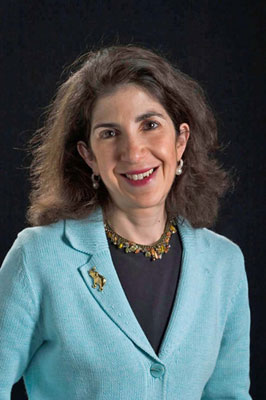
Fabiola Gianotti, an experimental physicist at CERN and deputy spokesperson for the researchers who identified the Higgs boson, will present "The Higgs Boson and Our Life" at Jefferson Lab, beginning at 7 p.m. on April 30. Photo: ATLAS Experiment © 2013 CERN
Jefferson Lab will hold a public Science Series Lecture on Tuesday, April 30, starting at 7 p.m. in the CEBAF Center auditorium. Fabiola Gianotti, an experimental physicist at CERN and deputy spokesperson for the researchers who identified the Higgs boson, will be presenting "The Higgs Boson and Our Life." On July 4, 2012, two research groups (running the ATLAS and CMS experiments) operating at Europe's CERN Large Hadron Collider (LHC) announced the discovery of a new particle compatible with the Higgs boson. Physicists have hunted the particle for almost 50 years, and describe it is a crucial piece for humanity's understanding of fundamental physics and, thus, the structure and evolution of the universe. The lecture will describe the unprecedented instruments and challenges that made such an accomplishment possible, the meaning and relevance of the discovery, and the implications for day-by-day life. Gianotti was named a Time magazine Person of the Year runner up for 2012 and earned international recognition during the experiment's run and when the results from the experiment were announced. More about the guest speaker is available online at: - http://home.web.cern.ch/about/updates/2012/12/time-honours-fabiola-gianotti-and-higgs-boson - http://www.atlas.ch/multimedia/interview-gianotti.html - A CERN Courier article titled: The Large Hadron collider runs on Woman Power from 2008, is posted online at: http://cerncourier.com/cws/article/cern/33806 - On Wikipedia at: http://en.wikipedia.org/wiki/Fabiola_Gianotti. The lecture is free and open to students and adults. It will begin at 7 p.m., in the CEBAF Center auditorium located at 12000 Jefferson Ave, Newport News, and will last about an hour. Seating in the auditorium and overflow area is available on a first-come, first-served basis and is limited to about 300 people. All those under age 16 must be accompanied by a parent or responsible adult. Everyone over 16 is asked to carry a valid photo ID. Security guards may perform ID, parcel and vehicle checks. For directions and additional information about Jefferson Lab public lectures, visit: http://education.jlab.org/scienceseries/ or contact Steve Gagnon, email at gagnon@jlab.org or call 757-269-6286. A live video stream is available for those not able to attend the event. Lectures are added to the video archive for on-demand viewing upon approval from the presenter. |
||||
|
|
||||
Student Reflects on Benefits, Opportunities Afforded by JSA Assistantship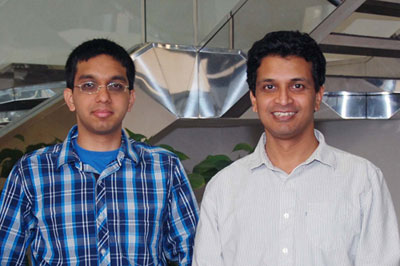
Prajwal Mohanmurthy (left), a Mississippi State University physics major, was recipient of the 2012 Jefferson Science Associates Minority Undergraduate Research Assistantship at Jefferson Lab. He was nominated for the assistantship by his adviser, Dipangkar Dutta, an associate professor in MSU's physics and astronomy department
A senior physics major attending Mississippi State University, who was the recipient of the Jefferson Science Associates Minority Undergraduate Research Assistantship at Jefferson Lab for 2012, says the award provided him with a wealth of experiences and professional contacts. The assistantship allowed Prajwal Mohanmurthy, originally from Bangalore, India, to continue his role in groundbreaking research – performing computer simulations to help demonstrate the concept of a spin-light polarimeter design being developed by his adviser, Dipangkar Dutta, an associate professor in MSU's physics and astronomy department. Mohanmurthy's research was based on developing a high-precision polarimetry technique and the design for a polarimeter for a future research facility – an Electron Ion Collider. The work led to the young researcher's undergraduate honors thesis, "A Novel Spin-Light Polarimeter for the Electron Ion Collider," which he defended on Nov. 25. A basic description of his work, pulled from the abstract of his paper reads in part: "…first, a rough calculation was drawn out to establish the validity of the idea for a spin-light polarimeter. Secondly, the fringe fields of the wriggler magnet was simulated using a two-dimensional magnetic field simulation toolkit called Poisson Superfish. This was used to account for beam motion effects and the corresponding correlations were shown to be negligible. Lastly, a full-fledged GEANT-4 simulation was built to study the response time of the ionization chamber. Currently, this simulation is being analyzed for a variety of effects that may hinder precision polarimetry." "I think the work that I did will have long-term applicability and value," he wrote in an e-mail. "It was part of a whole new technique; and the R&D required to make such a facility possible and feasible is very 'novel' as Dr. Dutta aptly calls it." Learning the nitty-gritty of experimental nuclear physics – from simulations to electronics design to actually running and analyzing data from an experiment – was the best part of the assistantship, according to Mohanmurthy. "Even though my project was focused on the simulation part, I had the chance do a little of all those jobs – giving me a holistic experience base. This was possible only because this program provides a long-term involvement," he said. The financial support that came with the assistantship, which is funded by the JSA Initiatives Fund, was of great help in buying equipment to make his project possible, according to Mohanmurthy. In addition to carrying out cutting-edge simulations, it also allowed him to attend conferences ranging from a local SESAPS meeting (Southeastern Section of the American Physical Society) to the International Nuclear Physics Conference. "The JSA assistantship and the grant that came with it was a catalyst in forming my own small research group (about four, mostly undergrads at any point in time) which now is actively involved in one other major experiment in our lab at MS State, and several smaller initiatives," he added. "The grant helped attract other funding, which is now supporting these other projects." For Mohanmurthy, other benefits of the assistantship included networking and broad exposure to the fields of theoretical physics, accelerator science, and nuclear and particle physics. “The conferences and workshops [that I attended] at Jefferson Lab and elsewhere were a good way to get to know the community better," he added. "Also, it demanded that I collaborate and work with people from other universities to make my work possible, so that was another way to network." He encourages minority undergraduate physics students who are interested in a research challenge to talk with their physics professors about eligibility to apply for the JSA assistantship. "This is one of the only programs that provides a fairly generous amount of support in terms of travel/research grant money and provides a period of involvement where one can work on a project long enough to call it their own, according to Mohanmurthy. "So, there is all the reason to try for this program," he notes. He plans to work for the High Performance Computing Collaboratory at Mississippi State this summer and then go to graduate school. When asked what field he is most interested in pursuing, his immediate response is experimental physics. "I didn't have to think twice before I said experimental nuclear-particle physics. A question I clearly had an answer ready for partly because of the experience I got working on this assistantship," he added. Mohanmurthy credits his adviser for much of his success and for many of the opportunities that have come his way. "I worked with Dr. Dutta for over three years before I received the assistantship. ... He's always been supportive of my ideas – the reasonable ones – and he's been a great mentor, patient to put up with all my gaffes and yet persistent in driving me in the right path. I think I am lucky to have such an adviser and I feel it is essential to develop a working appreciation of the field. I owe a lot of my success to being carefully advised by him," Mohanmurthy said. |
||||
|
|
||||
Below the Fold: |
||||
Teachers Invited to April 17 Science Activities Night at Jefferson Lab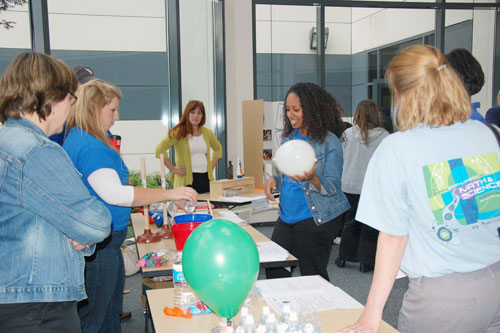
Elementary- and middle-school teachers interested in learning new and innovative methods for teaching the physical sciences are invited to attend Teacher Night at Jefferson Lab on April 17. More than 100 teachers attended each of the five previous events. Pictured, teachers check out some of the activities and demonstrations at the 2012 Teacher Night.
Elementary- and middle-school teachers interested in learning new and innovative methods for teaching the physical sciences are invited to attend the annual Region II Teacher Night, scheduled for Wednesday, April 17, at the Department of Energy's Jefferson Lab. The event will focus on physical science activities that teachers of fourth- through eighth-grade classes can use in the classroom. The evening's format will imitate a science fair. But instead of students showing off their science projects, more than 50 teachers will be sharing their favorite or most-effective classroom activities. The presenting teachers will provide handouts and many will have free teaching supplies to accompany the handouts. Activities will cover a range of topics, including friction, electrolysis, the water cycle, engineering design challenges, exothermic demonstrations, energy conservation, electricity, polymers, scientific investigation, science games, sound, force and motion, the periodic table, diffraction, the solar system, static electricity, renewable energy, and compounds and mixtures. Teacher Night will run from 6:30 to 8 p.m. in Jefferson Lab's CEBAF Center, located at 12000 Jefferson Ave., Newport News. To reserve a spot, or for more information, contact Brita Hampton no later than Wednesday, April 3; email hampton@jlab.org or call 757-269-7633. "The teachers presenting activities and demonstrations at Science Night are former and current participants in a teacher enrichment program conducted at Jefferson Lab," notes Lisa Surles-Law, a Jefferson Lab Science Education administrator. "They will be sharing many of the activities they have used in their classrooms. These teachers have spent a great deal of time and energy learning new science and teaching methods, and they want to share them with the larger teaching community. "More than 100 teachers attended each of the five previous events," Surles-Law adds. "Teacher Night is a great opportunity for sharing and learning and finding something new to take back to the classroom." The teacher enrichment program, JLab Science Activities for Teachers, and this teacher workshop are supported by the JSA Initiatives Fund, a grant program funded by Jefferson Science Associates, LLC. For your reference, download an informational flyer that includes driving instructions at: http://education.jlab.org/teachernight/flyer.pdf and from: http://education.jlab.org/teachernight/. For additional Teacher Resources visit Jefferson Lab's science education website at: http://education.jlab.org/. April 5 Deadline Nears for JSA Minority Research Assistantship NominationsJefferson Lab is seeking candidates for a research assistantship from an accredited SURA-member university. The assistantships are provided to minority undergraduate students to work on projects that are part of the lab's research program or directly related to the scientific or engineering aspects of the research program. Jefferson Science Associates will provide funds to support a student at his or her university during the 2013 - 2014 academic year. This assistantship is funded by the Jefferson Science Associates Initiatives Fund Program. Nominations must be submitted by a faculty sponsor before the student may apply. After the faculty member has nominated a student, the student will be sent an email with the link to the application form to be completed. Sponsor nominations are due by April 5. For more information and to submit the nomination of a student, visit: https://www.jlab.org/div_dept/admin/HR/research/index.html JSA is a joint venture between the Southeastern Universities Research Association and the Computer Sciences Corporation-Applied Technology Division to manage and operate Jefferson Lab for the U.S. Department of Energy's Office of Science. Student Receives Outstanding Doctoral Prize from China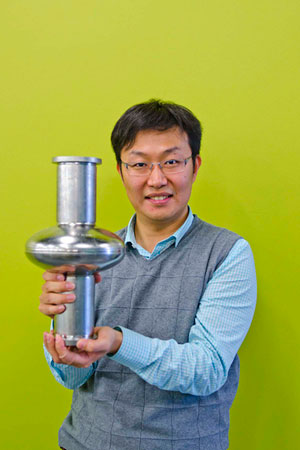
Chen Xu, a former College of William and Mary doctoral student who conducted research at Jefferson Lab has been named a recipient of a 2012 National Outstanding Overseas Doctoral Student prize from the People's Republic of China. The prize is part of China's National Merit Scholarship program. Xu is pictured holding a niobium test cavity.
A former College of William and Mary doctoral student who conducted research at Jefferson Lab – aimed at improving superconducting radiofrequency capabilities – has been named a recipient of a 2012 National Outstanding Overseas Doctoral Student prize from the People's Republic of China. Chen Xu, who presented his doctoral dissertation on Feb. 26, has been a student in the Applied Science department at William & Mary since August 2007. Xu has conducted a range of SRF research at Jefferson Lab under the guidance of his co-advisers, Charlie Reece, with Jefferson Lab's Superconducting Radiofrequency Institute, and Michael Kelley, Free-Electron Laser Applied Research program manager and a W&M professor. The prize awarded to Xu recognizes the outstanding achievements of high-caliber students studying outside of China, at their own expense. Those who win the prize are also encouraged to return to China after completing their education, according to China's department of education website. The prize was started in 2003 and is part of China's National Merit Scholarship program. It includes a $6,000 monetary award, which will be presented to Xu by China's ambassador to the U.S. during a ceremony later this year at the Chinese Embassy in Washington, D.C. A total of 490 students received a 2012 prize, with 140 of the recipients attending universities in the U.S. Xu has pursued theoretical and applied research into optimizing superconducting radiofrequency niobium cavity performance based on various types of surface processing of the cavities. His research is helping to address how to improve the energy efficiency of niobium cavities. The very innermost surface of the niobium cavity contributes the most to RF consumption, according to Xu. "The surface topography is a primary factor affecting surface resistance at high surface fields. The goal is to identify the polishing methods that can achieve a smooth niobium surface at a reasonable cost," he explains. "If you can reduce the surface resistance you can improve efficiency – consume less energy and get the same performance," he continues. By precisely measuring the surface roughness or topography of processed cavities and recording the performance of each cavity section, he can analyze the differing RF performances in conjunction with the quality factors and fields. "Some cavity processing recipes work well, but we don't know why," Reece explains. "Chen is helping us figure out why and how to optimize the best processes. Taking these measurements and analyzing the data is helping us understand the data so we can decide what needs to be done and how." While affiliated with Jefferson Lab, Xu has had three research articles published and has submitted a fourth. He has also had the opportunity to participate in five international SRF and accelerator conferences and workshops, where his work has earned student awards and he has been asked to present his results. Xu received the Best Student Poster Award at the 2012 International Particle Accelerator Conference, for his analysis of high field non-linear losses on SRF surfaces due to specific topographic roughness, and he was chosen to present his research at the TESLA Technology Collaboration meeting held at Jefferson Lab in November. In the letter nominating Xu for the scholarship award, Kelley wrote: …"He has been the central person in developing the application of the topography characterization approach used in optics to SRF accelerator cavities. In theory, he has addressed the issue of how surface topography affects SRF performance in terms of the deposition of energy into the cavity interior surface. This work is at the stage of being presented at the international conferences of our community, [and] has been well received as indicated by his awards. He is now preparing two major journal articles. …Clearly, he is a student of great intelligence and great energy. "A further characteristic of Chen Xu is that he is highly effective in developing fruitful relationships with other scientists at all levels, both at JLab and elsewhere. These collaborations are an asset to our programs and have helped us move forward more rapidly. Taken together, these indicate that he will be a versatile and excellent researcher, and that he will be a strong contributor to a research team. …I believe he will develop into a strong research team leader." Xu is now working at Stanford University, but hopes to return to Jefferson Lab one day. "Jefferson Lab has a world-leading position in SRF," Xu said. "I am most grateful for the opportunities I've had here. I look forward to returning to the lab some day and helping to advance the field of accelerator physics, and Jefferson Lab's leading position in this field." First-Time Competitor, Nysmith, Wins Va. Middle School Science Bowl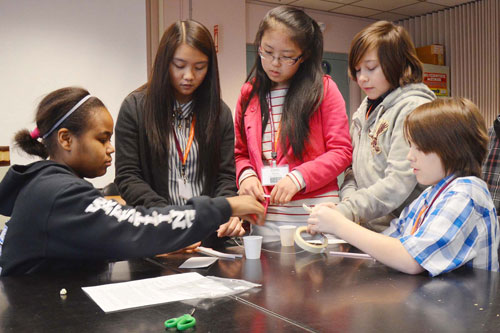
A number of teams that didn't advance to the finals at the Virginia Middles School Science Bowl matches participated in a design and engineering challenge dubbed the Stay All Day contest. Pictured, a middle school team starts working on a project called Work and Power.
After an intense day of academic competition, a team participating in the Department of Energy's National Science Bowl competition for the first time won the Virginia Regional Middle School Science Bowl. The team from Nysmith School, Herndon, made it through the morning round robin undefeated. It won its first three afternoon double-elimination matches, before losing to the defending champion - Longfellow Middle School, Falls Church - in its fourth match of the afternoon. With one loss each, Nysmith and Longfellow were forced into a face-off match. The score was close at the half, 32 - 26, but at the buzzer Nysmith had pulled ahead 68 – 38 by correctly answering more bonus questions. For its first-place finish, Nysmith, a team of sixth-, seventh- and eighth-graders coached by Sujatha Golla and Minal Bhandarkar, took home a $750 check for its school, a regional banner the team will carry to nationals, a trophy and individual medals. The team will also receive an expenses-paid trip to participate in the National Science Bowl finals – in Washington, D.C., April 25-29. Longfellow, winners of the Virginia Middle School Science Bowl in 2012, 2011 and 2010, and coached by Jim Bradford, finished in second for the first time since 2009. The team took home a $500 check and a team trophy. Finishing in third was Rachel Carson Middle School, coached by Velayudhan Rajan. The team won a $300 check and a team trophy. The team from Rocky Run Middle School, Chantilly, and coached by Mary Erdeljon and Joy Pryde Haskins, finished in fourth and earned a trophy for its efforts. A number of teams that didn't advance to the afternoon finals matches participated in a design and engineering challenge dubbed the Stay All Day contest. Each team participated in two activities that posed design and engineering challenges. At its conclusion, Catholic STEM, Virginia Beach, was the team with the best composite score. The team, coached by Melinda Mericle and Heather Mericle-Sherburne, earned a $300 check. The team did the best at creating a structure from masking tape and uncooked spaghetti and finished in second in developing a wind-driven (breathe) machine and calculating power. Team members also received individual prizes. "We are delighted that the Stay All Day activities have become an integral part of the Virginia Science Bowls," said Tyler. "The Stay All Day activities are a great way to present some basic design and engineering challenges to students. These activities encourage the students to brainstorm, to incorporate math skills and scientific principles into a hands-on activity, and to work in teams." At the awards ceremony at the end of the day, Tyler commended the teams for their knowledge and level of preparation and for their conduct. She encouraged them to continue pursuing their interests in math, the sciences and technology. She applauded the coaches for the time and effort they put into preparing their teams for competition. TESLA Collaboration Draws More Than 150 Researchers to Lab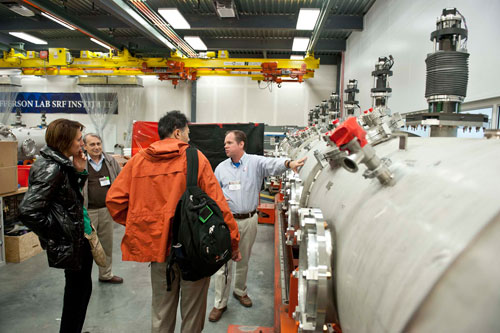
Nearly 100 researchers toured Jefferson Lab in conjunction with the TESLA Technology Collaboration meeting. The highlight of the tour was visiting the Superconducting Radiofrequency R&D labs and SRF component processing, assembly and testing work centers. Here tour participants discuss cryomodule assembly with John Hogan, senior staff engineer.
The TESLA Technology Collaboration meeting held at Jefferson Lab in November drew more than 150 researchers representing 28 countries and 40 institutions. It was the group's first meeting at Jefferson Lab and among the few times the group has met in the U.S. On Nov. 6, nearly 100 of the attendees toured the lab. A highlight of the tour was visiting Jefferson Lab's Superconducting Radiofrequency R&D labs as well as SRF component processing, assembly and testing work centers newly relocated from the Test Lab to the Test Lab Addition during 2012. These meetings are highly anticipated and provide productive opportunities for advancing the SRF field, according to Charlie Reece, a senior scientist of Jefferson Lab's Institute for Superconducting Radiofrequency Science and Technology and the lab's coordinator for the Nov. 5-8 meeting. The meetings also provide a good opportunity for networking, sharing ideas and discussing scientific and technological advancements and challenges. He describes the gatherings as a good mix of senior researchers in the field along with many new, young researchers. Even though many of the lab's SRF groups had to stop their research in February 2012 to prepare for the move to the Test Lab Addition, and had just begun operations in various work centers by the end of the year, progress was sufficient so that many of the TTC attendees were impressed by the capabilities of the SRF Institute, according to Reece. "Even though most of what we showed was not new to us, they had not seen our capabilities before and didn't realize the depth and breadth of what we do here. "We have the best SRF development facility in the world," he continued. "It is a platform for creating new processes and designs. We did our best to stoke interest from others who may seek our collaborative contribution to their future projects or needs." Research topics such as SRF materials research and novel RF structure designs for new applications, were discussed at the meeting, as were common issues. Issues included contamination control strategies that need to be strengthened to assure best performance for accelerator operation, and technology developments vital to pushing SRF system costs down. Opportunities were identified for cost reduction, according to Reece, but are lightly funded, since money primarily goes to fund projects already within a high-confidence level. The TTC group's mission is to advance superconducting radiofrequency technology, R&D and related accelerator studies across a range of scientific applications and across its international collaboration. Fulvia Pilat, the Accelerator Division's deputy associate director, is the America's representative on the TTC executive committee. Virginia Launches Free Emergency Preparedness Mobile AppGov. Bob McDonnell has announced a way for Virginians to become "mobile ready" for disasters. The Ready Virginia mobile application, developed by the Virginia Department of Emergency Management, gives Virginians a new way to prepare for disasters and to stay informed during emergencies and quickly identify services and other valuable resources regardless of their location. The free Ready Virginia app for iPhone® and Android™ mobile devices provides emergency planning and preparedness guidance along with several other important features, including: - Location- specific weather watches and warnings as well as flood information issued by the National Weather Service - Disaster news from the Virginia Department of Emergency Management - Maps with open American Red Cross shelters, hurricane evacuation routes, hurricane storm surge zones and stream gauges - A template for creating a customized family emergency plan that can be easily shared - Local emergency manager contact information - Links to register for local emergency alerts In addition to the mobile app, the Virginia Department of Emergency Management launched a mobile version of its website at m.vaemergency.gov. The mobile site contains all the information available on VDEM's regular website, but with easier navigation for those who use smart phones and tablets to access websites. "This new app is one of the most important ones Virginians can install on their mobile devices. Now our citizens can get ‘mobile ready’ and ensure that their families are prepared for emergencies and stay informed with official disaster information when an emergency occurs," said McDonnell. The Ready Virginia app is available for download in the App Store SM and in Google Play™ for Android™. Find the listing on Apple Store: https://itunes.apple.com/us/app/id579344082?mt=8. Find the listing on Google Play: https://play.google.com/store/apps/details?id=com.cop.vdem.virginia.gov.viper&feature=search_result#?t=W251bGwsMSwyLDEsImNvbS5jb3AudmRlbS52aXJnaW5pYS5nb3YudmlwZXIiXQ.. This VDEM news release is post at: http://www.vaemergency.gov/news/news-releases/2013/mobile-app-ready Milestones for FebruaryHello Goodbye These Milestone entries, listed alphabetically, are full-time, term, casual and student actions posted by Human Resources for February 2013. Jefferson Lab is currently seeking qualified individuals for nearly a dozen positions, including engineering, technical, finance and student positions. All current employment opportunities are posted at: https://careers.peopleclick.com/careerscp/client_jeffersonlab/external/search.do Information about career opportunities at Jefferson Lab is available at: https://www.jlab.org/job-openings Scrapbook PhotosGetting the Latest Info on the New U.S. Patent Law 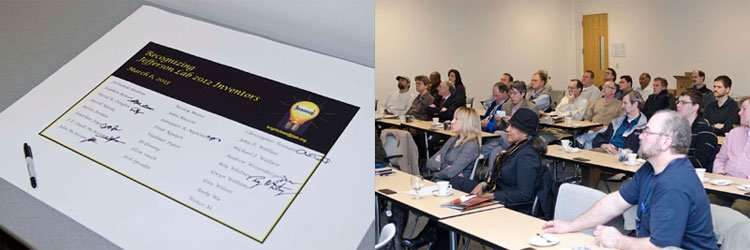 Lab staff received information about the new patent rules that went into effect across the U.S. on March 16 during a seminar held in early March. Jefferson Lab's Technology Review Committee hosted the seminar with guest speaker, Michael Badagliacca, from the Department of Energy Patent Office. He discussed the America Invents Act and how the conversion from a "first to invent" to a "first to file" system will affect future patents. The event also provided a venue for recognizing lab staff that made patent disclosures of new Intellectual Property in 2012. More information and reference links regarding First-Inventor-to-File provisions are available on the Patents Examination page at: http://www.uspto.gov/aia_implementation/patents.jsp# and under heading 10 First-Inventor-to-File at: http://www.uspto.gov/aia_implementation/patents.jsp#heading-10. |
||||
|
The On Target newsletter is published monthly by the Thomas Jefferson National Accelerator Facility (Jefferson Lab), a nuclear physics research laboratory in Newport News, Virginia, operated by Jefferson Science Associates, LLC, for the U.S. Department of Energy's Office of Science. Possible news items and ideas for future stories may be emailed to jlabinfo@jlab.org, or sent to the Jefferson Lab Public Affairs Office, Suite 15, 12000 Jefferson Avenue, Newport News, VA 23606
|
||||


 During the past two years, 62 tornadoes struck Virginia, killing 10 people and injuring more than 100. To encourage tornado awareness and safety, Gov. Bob McDonnell proclaimed March 12 as Tornado Preparedness Day....
During the past two years, 62 tornadoes struck Virginia, killing 10 people and injuring more than 100. To encourage tornado awareness and safety, Gov. Bob McDonnell proclaimed March 12 as Tornado Preparedness Day....  Jefferson Lab will hold a public Science Series Lecture on Tuesday, April 30, starting at 7 p.m. in the CEBAF Center auditorium......
Jefferson Lab will hold a public Science Series Lecture on Tuesday, April 30, starting at 7 p.m. in the CEBAF Center auditorium......  The recipient of the JSA Minority Undergraduate Research Assistantship at Jefferson Lab for 2012, says the award provided him with a wealth of experiences and professional contacts....
The recipient of the JSA Minority Undergraduate Research Assistantship at Jefferson Lab for 2012, says the award provided him with a wealth of experiences and professional contacts....